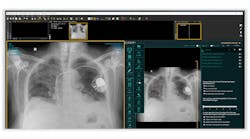The dream of imaging informatics executives is to get CD-ROMs out of the workflow. But they are stubbornly persistent — like fax machines in physician offices.
During a recent webinar put on by the Society for Imaging Informatics in Medicine (SIIM), two executives described their strategies for handling images arriving from other organizations.
Alexander Towbin, M.D., associate chief of radiology informatics at Cincinnati Children’s Hospital, said the hospital gets medical images from around the world because it is a center of excellence for many conditions. Historically those came via CD, but that is changing.
Putting it bluntly, Towbin said, “CDs suck!” There are so many opportunities for error to be introduced. Some institutions put passwords on them and don’t share them. Some forget to burn them. Some CDs arrive with the label on the readable side. “They do everything they can to screw it up and then they do it over again,” he said.
As Cincinnati Children’s has moved to cloud solutions for image sharing, there are still problems they have to deal with, such as accession numbers that are too long and can’t be ingested into the PACS. But automation tools allow them to fix those problems across all a patient’s files. “That has been huge,” Towbin said. “The decrease in the number of problems from CDs has been huge for us.”
In its own region, the healthcare organizations previously were on one image-sharing platform, but the vendor went out of business. Now the provider organizations are on multiple cloud-based solutions, and Cincinnati Children has created a hub-and-spoke gateway, which sends imaging studies into its PACS. “That works well for ones we have relationship with,” Towbin said.
Putting images on CDs is also bad for patient engagement, Towbin stressed. “The concept that we provide people with CDs is ludicrous. We are asking them to act as delivery people. Apple got rid of them six or seven years ago. Most computers don’t have them. Even in radiology, we have to buy add-ons for computers.”
Kevin McEnery, M.D., director of innovation in imaging informatics at the University of Texas MD Anderson Cancer Center, said, “We see the cloud as indispensable for moving forward. We see it decreasing complexities of image transfers. It simplifies the logistics of moving images between institutions without sacrificing security.” His organization is migrating away from CD-ROMs as well. But with 16,000 to 18,000 studies processed per month, there is still a lot of investment in employee time in getting images into the PACS. “We could use a lot more automation than exists with the current infrastructure,” he said.
Rather than having patients shuffle CDs to other providers, MD Anderson has hired a third-party company. Once someone is an MD Anderson patient, the vendor calls and asks where they have had imaging and takes care of it from there. “It decreases stress and increases the number of studies available to get a more complete picture of the patient’s condition,” McEnery said.
Towbin said the hub-and-spoke approach with other institutions has had its challenges in terms of project management. The other organizations might not necessarily see working on this as a high priority. “It is a way for them to send images to us — an above-and-beyond thing we are asking them to do. It is a huge stressor on our informatics team — getting external providers interested in using our solution,” he said. There is a lot of trial and error to get it working, and understand work flows. The experts on our teamwork to understand the best work flow for each institution. It was and continues to be a challenge to roll this out to everyone else.”
Beyond getting images into the PACS, another issue is getting access to prior imaging reports, McEnery said. “They are coming through a different pathway — on that fax pathway. We are putting a bigger emphasis on not just improving how we get images but also how we get reports from the institution the image is coming from on their understanding of the disease process.”
On Cincinnati Children’s roadmap is image-enabling its patient portal to allow patients to push images elsewhere or download them. “It is doable and where we need to move. It is difficult to image-enable the patient portal, but not impossible.”


